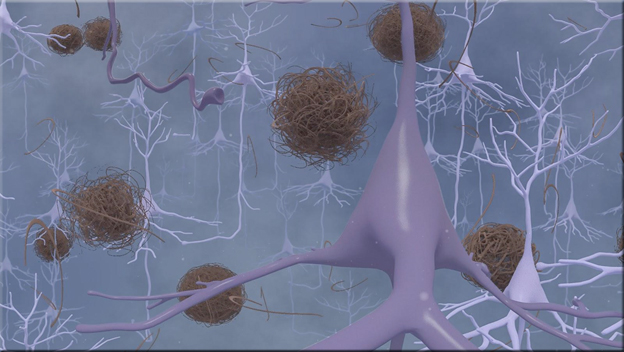This three-part lab can be experienced all at once or separately. At the beginning of each part, Beatriz’s brain acts as an omniscient narrator, helping learners understand how changes to the brain affect daily life and interactions.
Pre and post assessments, along with a facilitation guide, allow learners and instructors to see progression towards outcomes that are addressed through the story and content in the three parts, including:
1) increased knowledge of Alzheimer’s disease and the brain
2) enhanced confidence to care for people with Alzheimer’s disease
3) improvement in care practice
Why a lab about Alzheimer’s Disease?
The Beatriz Lab is very important to us at Embodied Labs. It is the experience that inspired the start of our company. We believe VR is more than a way to evoke feelings of empathy; rather, it is a powerful behavior change tool. By taking the perspective of Beatriz, healthcare professionals and trainees are empowered to better care for people with Alzheimer’s disease, leading to more effective care practices and better quality of life. Through embodying Beatriz, you will gain insight into life with Alzheimer’s and be able to better connect with and care for your loved ones, patients, clients, or others in this communities who live with the disease every day. In our embodied VR experience, we hope to portray both the difficult and joyful moments — the disease surely is a mix of both.
Watch our new promo video to learn more!

As part of the experience, you will take a 360 degree trip into Beatriz’s brain,
and visit a neuron “forest” that is being affected by amyloid beta plaques and tau proteins.
From DSC:
I love the work that Carrie Shaw and @embodiedLabs are doing! Thanks Carrie & Company!
Top 7 Business Collaboration Conference Apps in Virtual Reality (VR) — from vudream.com by Ved Pitre
Excerpt (emphasis DSC):
As VR continues to grow and improve, the experiences will feel more real. But for now, here are the best business conference applications in virtual reality.
Final Cut Pro X Arrives With 360 VR Video Editing — from vrscount.com by Jonathan Nafarrete
Excerpt:
A sign of how Apple is supporting VR in parts of its ecosystem, Final Cut Pro X (along with Motion and Compressor), now has a complete toolset that lets you import, edit, and deliver 360° video in both monoscopic and stereoscopic formats.
Final Cut Pro X 10.4 comes with a handful of slick new features that we tested, such as advanced color grading and support for High Dynamic Range (HDR) workflows. All useful features for creators, not just VR editors, especially since Final Cut Pro is used so heavily in industries like video editing and production. But up until today, VR post-production options have been minimal, with no support from major VR headsets. We’ve had options with Adobe Premiere plus plugins, but not everyone wants to be pigeon-holed into a single software option. And Final Cut Pro X runs butter smooth on the new iMac, so there’s that.
Now with the ability to create immersive 360° films right in Final Cut Pro, an entirely new group of creators have the ability to dive into the world of 360 VR video. Its simple and intuitive, something we expect from an Apple product. The 360 VR toolset just works.
See Original, Exclusive Star Wars Artwork in VR — from vrscount.com by Alice Bonasio

Excerpt:
HWAM’s first exhibition is a unique collection of Star Wars production pieces, including the very first drawings made for the film franchise and never-before-seen production art from the original trilogy by Lucasfilm alum Joe Johnston, Ralph McQuarrie, Phil Tippett, Drew Struzan, Colin Cantwell, and more.
Learning a language in VR is less embarrassing than IRL — from qz.com by Alice Bonasio
Excerpt:
Will virtual reality help you learn a language more quickly? Or will it simply replace your memory?
VR is the ultimate medium for delivering what is known as “experiential learning.” This education theory is based on the idea that we learn and remember things much better when doing something ourselves than by merely watching someone else do it or being told about it.
The immersive nature of VR means users remember content they interact with in virtual scenarios much more vividly than with any other medium. (According to experiments carried out by professor Ann Schlosser at the University of Washington, VR even has the capacity to prompt the development of false memories.)
Since immersion is a key factor in helping students not only learn much faster but also retain what they learn for longer, these powers can be harnessed in teaching and training—and there is also research that indicates that VR is an ideal tool for learning a language.
Addendum on 12/20/17:
- Virtual reality lets scientists walk around inside cancer cells, set to revolutionise medicine — from abc.net.au by Sophie Scott










